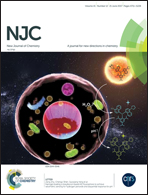A turn-off fluorescence sensor for insensitive munition using anthraquinone-appended oxacalix[4]arene and its computational studies
Abstract
Herein, a fluorescent oxacalix[4]arene-based receptor, DAQTNOC(5,17-di(N-(9,10-dioxo-9,10-dihydroanthracen-1-yl)acetamide) tetranitrooxacalix[4]arene), was described for the specific recognition of N-methyl-p-nitroaniline (MNA). Among the array of explosives, DAQTNOC shows selective behaviour for MNA in the absorption and as well as emission spectra. The binding constants, stoichiometry, quantum yields, and fluorescence quenching were determined to elucidate the inclusion behaviour. Furthermore, computational insights were rendered for studying the stability and spectroscopic analysis of the inclusion complex using docking, molecular dynamics simulations, and density functional theory (DFT) along with time-dependent density functional theory (TD-DFT). The calculations considerably complement the findings and elucidate the structural geometry and mode of interactions in supramolecular complexation. Herein, we observed that DAQTNOC was selectively stabilized by van der Waals forces and hydrophobic contacts with MNA to generate a low-energy complex. These findings are of wide interest, especially because MNA is a well-known insensitive munition and has been detected for the first time via an oxacalixarenes platform.
![Graphical abstract: A turn-off fluorescence sensor for insensitive munition using anthraquinone-appended oxacalix[4]arene and its computational studies](/en/Image/Get?imageInfo.ImageType=GA&imageInfo.ImageIdentifier.ManuscriptID=C7NJ01111C&imageInfo.ImageIdentifier.Year=2017)


 Please wait while we load your content...
Please wait while we load your content...